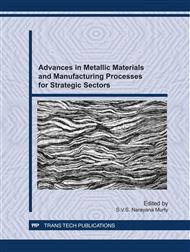p.407
p.412
p.421
p.427
p.433
p.439
p.445
p.451
p.457
Effect of Tempering Temperature on Strength and Fracture Toughness of 0.3C-CrMoV(ESR) Steel
Abstract:
0.3C-CrMoV(ESR) steel is an ultra-high strength low alloy steel indigenously developed by ISRO for space applications. The steel is used in the form of rings of 2.8 m diameter also. In this paper, the effect of tempering temperature on ring rolled steel for the best combination of fracture toughness and strength properties is studied. The tensile properties and fracture toughness of the steel were evaluated in the as quenched and tempered conditions through the specimens drawn in radial direction of the ring segment. Five tempering temperatures were used in the study: 200, 450, 475, 500 and 510°C. Tensile strength of the steel showed continuous decrease with increasing tempering temperature, but yield strength increased reaching maximum when tempered at 450°C and further decreased with increasing tempering temperature. The elongation was higher for higher tempering temperature. The strain hardening exponent decreased with increasing tempering temperature. The fracture toughness test results showed that tempering between 475 and 510°C exhibited better combination of fracture toughness and strength.
Info:
Periodical:
Pages:
433-438
Citation:
Online since:
January 2012
Price:
Сopyright:
© 2012 Trans Tech Publications Ltd. All Rights Reserved
Share:
Citation:


